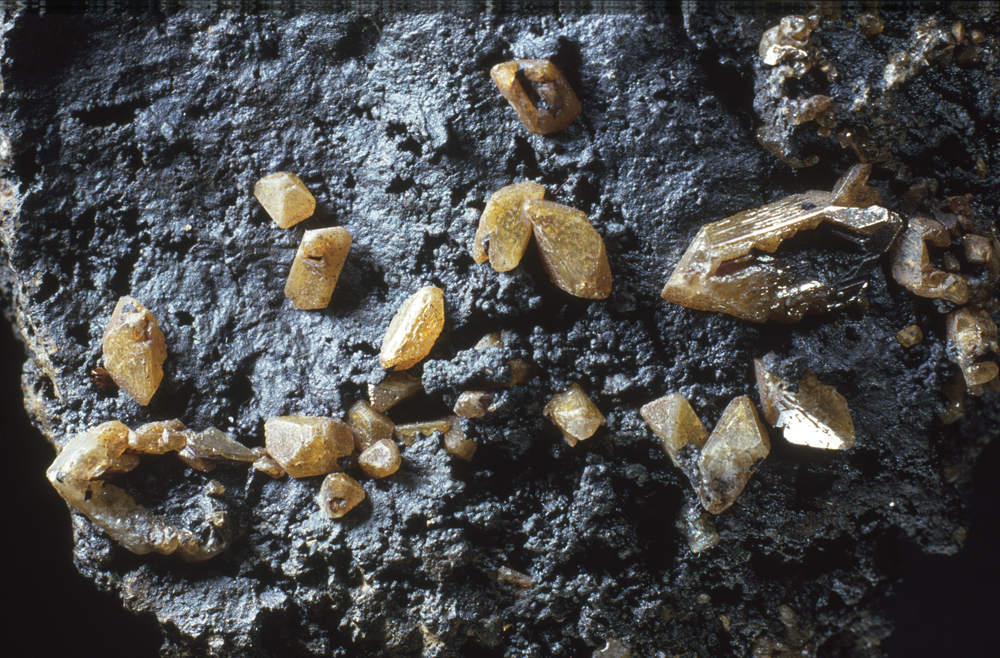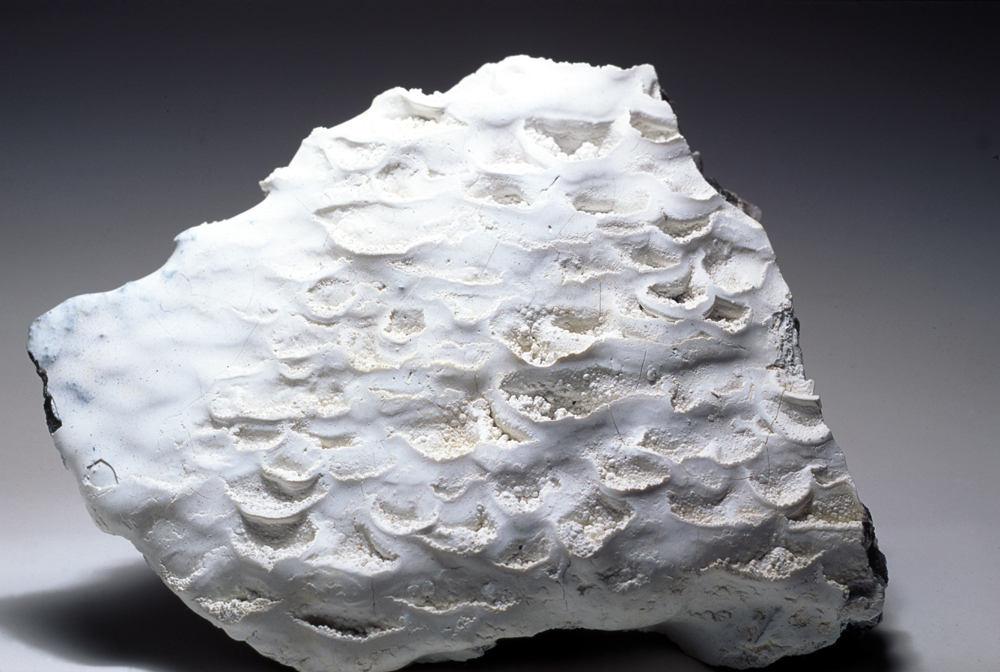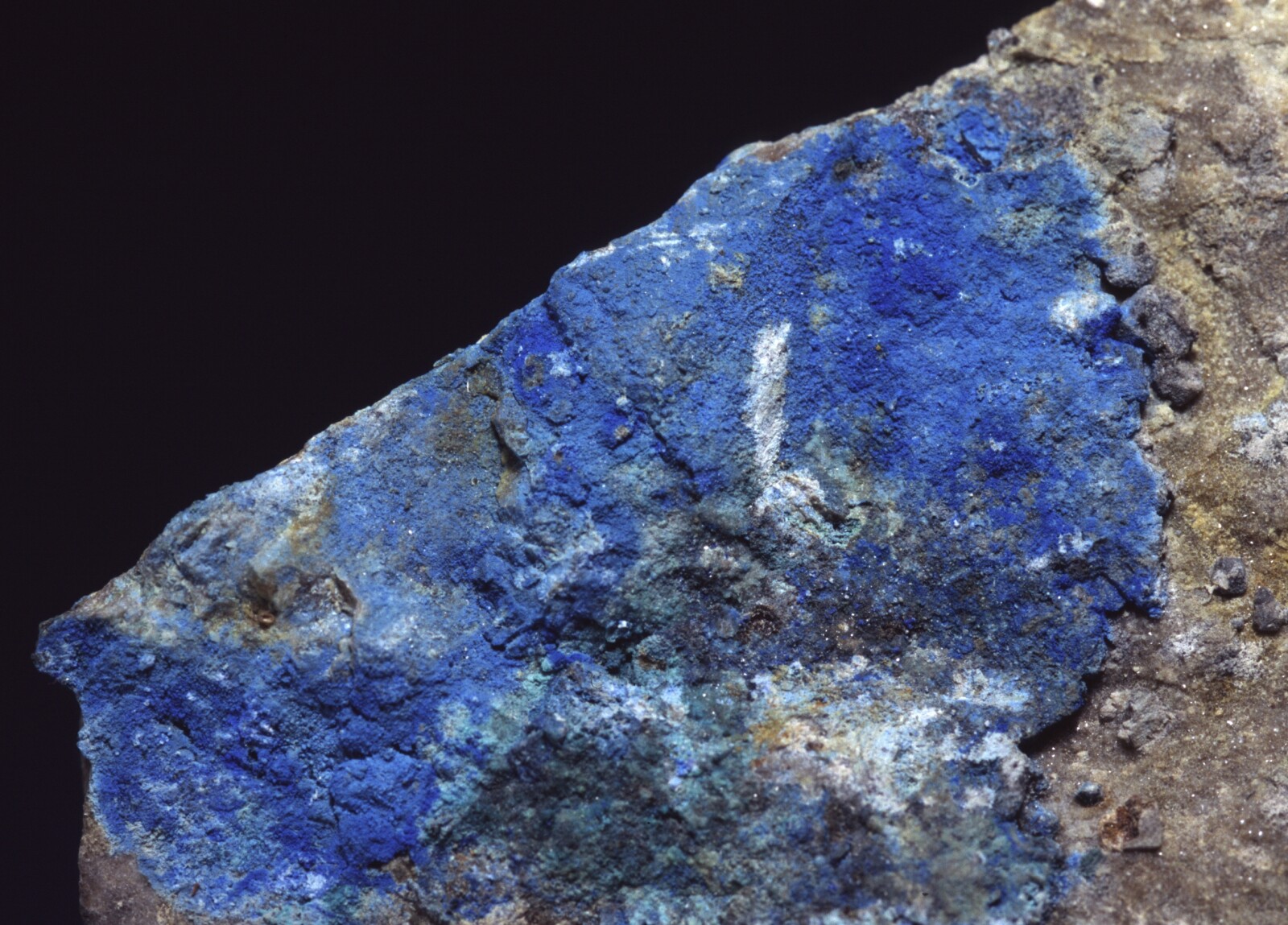Supergene Minerals
What is a supergene mineral?
Wales supergene mineral occurrences can be split into three categories, only two of which are currently accepted by the International Mineralogical Association (IMA) as genuine minerals. Since the mid-1990s, substances found crystallized on manmade substrates, such as smelter-slags and mortar rubble, have ceased to be included as minerals.
- Supergene - in situ natural oxidation & weathering deposits
- Supergene - post-mining oxidation & weathering deposits
- Supergene - minerals on an artificial substrate
Supergene - in situ natural oxidation & weathering deposits
The most widespread supergene mineral associations in Wales are those formed by natural processes on naturally occurring ores. In some cases (e.g. Great Orme copper-mines) these secondary minerals were present in sufficient abundance as to constitute workable ores themselves.
Such associations typically form close to the surface (<100 m), although in unusually permeable strata the weathering may penetrate to much greater depths. Permeability is an important factor as the weathering agents require transportation by water: climate is also critical as it controls availability of water. The most intense weathering takes place in tropical climates where warmth and abundant rainfall combine to create ideal conditions. Wales experienced such a climate during most of the Tertiary period and remnants of deep weathering zones are locally preserved along some mineralized fracture-systems. It has been proposed that such weathering was originally widespread, but that much of the evidence was eroded away during the repeated major glaciations of the Quaternary period, since which a relatively limited amount of weathering has taken place.
Chemical weathering involves both the alteration of pre-existing primary minerals to new products in situ and the transport and redeposition of dissolved substances. Three different type of supergene mineral development are recognized:
- Bulk-weathering
- Karstic deposits
- Oxidised zones of ore deposits
Bulk-weathering products are formed by the deep leaching of entire rock units and alteration of rock-forming minerals into supergene products in situ. Classic examples of such deposits - such as the laterites derived from basaltic lavas - are absent from Wales. However, highly-bleached or reddened rocks occasionally observed along faults (not necessarily mineralized) bear testimony to the process. The reddening is due to the oxidation of iron from Fe2+ (for example, in siderite or in some silicates) to Fe3+ (the oxide, hematite).
Karstic deposits are formed by dissolution of carbonate-bearing rocks by groundwaters which transport and redeposit the supergene products (chiefly aragonite) elsewhere. The transport distance varies between localized (stalactites and stalagmites in limestone caves) to more distal (tufa deposits formed around calcareous springs). Good Welsh examples are known from the Carboniferous Limestone outcrops both in South and in north-east Wales.
Oxidized zones of ore deposits form where a combination of deep leaching and migration of dissolved substances occur, leading to often highly-zoned complex mineral assemblages. Here, the mineralogy is chiefly dependant on the original ore minerals present and their abundance relative to one another, with the composition of the host rock an added factor. For example, abundant pyrite weathers readily to give iron oxides (which remain in situ as gossans) and sulphuric acid (which is transported downwards and attacks more stable sulphides such as galena). Even a minor quantity of arsenopyrite will give rise to supergene arsenate minerals, while the presence of limestone as a wall-rock will release sufficient carbonate ions into the equation to ensure that the secondary assemblage is itself carbonate-dominated. Many good examples of this type of supergene mineralization are known from Wales, including the anglesite-bearing gossan at Parys Mountain, the malachite-dominated assemblage at Great Orme, the cerussite-pyromorphite dominated deposits at Frongoch Mine in Central Wales and the complex, arsenate-rich supergene mineralization at Dolyhir Quarry.

Anglesite crystals, up to 10 mm across, on gossan, from the type locality, Parys Mountain, Anglesey, North Wales. National Museum of Wales Collection (NMW 86.83G.M.1). Photo M.P. Cooper, © National Museum of Wales.
Supergene - post-mining oxidation & weathering deposits
Sulphide minerals are unstable to highly unstable in surface conditions, as witnessed by the collection curator's headache known as pyrite-decay, which can turn a freshly collected shiny pyritized ammonite into a pile of stinking, sulphurous fragments within weeks in the worst cases. Likewise, when miners drive a tunnel through an orebody, or tip low-grade sulphide-bearing rock onto spoil-heaps, they create an artificial environment in which the sulphides present are immediately attacked by natural weathering processes.

Hydrozincite showing ripple structure formed during growth from mine waters in No. 3 Level, Parc Mine, Llanrwst, Gwynedd. Specimen is 11.5 cm across. National Museum of Wales Collection (NMW 85.70G.M.29). Photo M.P. Cooper, © National Museum of Wales.
The products of such processes, be they flowstones on mine walls, or encrustations on and within rock fragments on mine-tips, are referred to as post-mining minerals. This is an important distinction. The mineral assemblages produced by post-mining oxidation differ considerably from those formed by fully natural weathering. Often, they have formed over a period of two hundred years or less: because the chemical reactions involved are slow, the chemical systems present have not reached equilibrium in the way that the entirely natural ones largely have. The result is mineral assemblages of considerable complexity often including many species that are under normal circumstances unstable: in fact an increasing number of mineral species are only known from such assemblages.

Blue crust of secondary copper minerals, including carbonate-cyanotrichite, formed on the wall rock of Wedding Cave Mine, near Wrexham. National Museum of Wales Collection (NMW 2003.13G.M.1). Photo D.I. Green, © National Museum of Wales.
Such mineral assemblages are very common in Wales, although mine tips producing good specimens are less so. Central Wales is one of the most well-known areas for post-mining assemblages but other areas include the Dolgellau Gold-belt, the Abersoch area on Llŷn (where tipping galena and chalcopyrite-bearing veinstone onto the beach has led to the formation of post-mining metal chlorides), and in the Llanrwst district, where the underground workings host the type locality of the rare copper-zinc basic sulphate, namuwite, named after the National Museum of Wales in 1982.
Post-mining minerals, usually microcrystalline but often colourful and attractive when viewed under the binocular microscope, have become increasingly popular with mineral collectors in recent decades. However, they are also of considerable importance to environmental geochemists because the processes that lead to their formation serve to lock up otherwise mobile metals into solid substances. Better understanding of the chemistry of such systems may in future lead to ways of dealing with polluted waters flowing from mines.
Supergene - minerals on an artificial substrate
"In general terms, a mineral is an element or chemical compound that is normally crystalline and which has been formed as a result of geological processes" - E.H. Nickel, 1995, writing in Definition of a Mineral.
Substances found in cavities in weathered smelter-slags or encrusting building-rubble are no longer regarded as minerals. The distinction is based on the notion that Man has had too much involvement in their formation because the matrix itself is manmade. Despite this, the geological processes by which they have formed, once the matrix has been left to weather, are virtually the same as those involved in forming post-mining minerals, and despite the declassification their popularity remains high among many mineral collectors, for the same reason as post-mining minerals are popular, in that they are often brightly-coloured and well-crystallized when viewed with the binocular microscope.
Although any new substances known only from weathered smelter slags and other manmade matrices will not in future be accepted as valid mineral species, minerals originally described from such environments prior to the declassification will remain valid. An interesting example is the tin oxychloride abhurite, a rare mineral with the only known Welsh occurrence forming as encrustations on tin ingots from a shipwreck off Anglesey.
At present such minerals continue to be included within The Mineralogy of Wales database.
Reference
Nickel, E.H., 1995. Definition of a mineral, Mineralogical Magazine, 59, 767-768).
